

Изучение аккадского языка в Интернете. A passage from Gilgamesh epic, pronounced in ancient Babylonian language. Hear The Epic of Gilgamesh Read in the Original Akkadian and Enjoy the Sounds of Mesopotamia. Long ago, in the ancient civilization of Mesopotamia, Akkadian was the dominant language.

And, for centuries, it remained the lingua franca in the Ancient Near East. But then it was gradually squeezed out by Aramaic, and it faded into oblivion once Alexander the Great Hellenized (Greekified) the region. Now, 2,000+ years later, Akkadian is making a small comeback. At Cambridge University, Dr. Martin Worthington, an expert in Babylonian and Assyrian grammar, has started recording readings of poems, myths and other texts in Akkadian, including The Epic of Gilgamesh.
Follow Open Culture on Facebook and Twitter and share intelligent media with your friends. If you'd like to support Open Culture and our mission, please consider making a donation to our site. Via Heritage Key Related Content: World Literature in 13 Parts: From Gilgamesh to García Márquez The Ancient History Learning Guide What Ancient Greek Music Sounded Like: Hear a Reconstruction That is ‘100% Accurate’ Knowledge and Power - Cuneiform Revealed: an introduction to cuneiform script and the Akkadian language. Home » Cuneiform Revealed The cuneiform script can seem bafflingly complex at first.
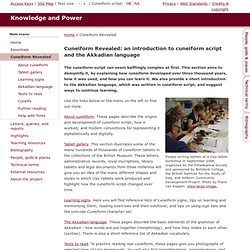
This section aims to demystify it, by explaining how cuneiform developed over three thousand years, how it was used, and how you can learn it. We also provide a short introduction to the Akkadian language, which was written in cuneiform script, and suggest ways to continue learning. People writing tablets at a clay tablet workshop in September 2008, organised by the Enheduanna Society and sponsored by Birkbeck College, the British Institute for the Study of Iraq, and Holborn Community Development Project.
Photo by Frans van Koppen. Use the links below or the menu on the left to find out more. Introductory Babylonian. eTACT. eTACT aims to be the definitive repository on the Web for translations of Akkadian materials.
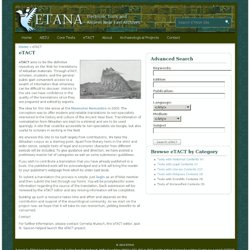
Through eTACT, scholars, students, and the general public gain convenient access to a wealth of information that otherwise can be difficult to discover. Visitors to the site can have confidence in the quality of the translations since they are prepared and edited by experts. The idea for this site arose at the Muenster Rencontre in 2006. The conception was to offer modern and reliable translations to non-specialists interested in the history and culture of the Ancient Near East.
Transliteration of normalization from Akkadian are kept to a minimal and are to be used sparingly. We envision this site to be built largely from contributions. If you wish to contribute a translation that you have already published in a book, the published work will be acknowledged and a link will bring the reader to your publisher's webpage from which to order said book. To submit a translation the process is simple.
Akkadian Cuneiform inscriptions. Loading books...
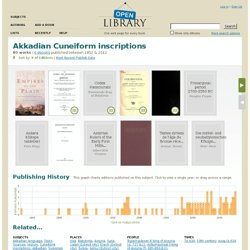
Open Library is unaware of any editions about this subject published between 1852 & 2012. Zoom out again ? Publishing History This is a chart to show the publishing history of editions of works about this subject. Along the X axis is time, and on the y axis is the count of editions published. Click here to skip the chart . Editions Published Year of Publication. Akkadian language (Babylonian and Assyrian cuneiform texts) Home page (DUB.E = tuppi bitim, 'home clay tablet') on Akkadian, an introduction collected by John Heise.
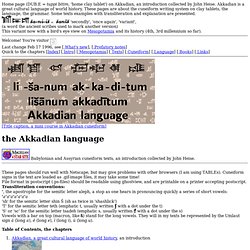
Akkadian is a great cultural language of world history. These pages are about the cuneiform writing system on clay tablets, the language, the grammar. Some texts examples with transliteration and explanation are presented. 'secondly', 'once again', 'variant', (a word the ancient scribes used to mark another version) This variant now with a bird's eye view on Mesopotamia and its history (4th, 3rd millennium so far). Welcome! Last change Feb 17 1996, see [ What's new], [ Prefatory notes] Quick to the chapters [Index] [ Intro] [ Mesopotamia] [ Texts] [ Cuneiform] [ Language] [ Books] [ Links] [Title caption, a mini course in Akkadian cuneiform] Babylonian and Assyrian cuneiform texts, an introduction collected by John Heise.
These pages should run well with Netscape, but may give problems with other browsers (I am using TABLEs). ) stand for the long vowels. Digital General Collection. A Concise Dictionary of Akkadian ? addenda, corrigenda, and supporting bibliography. Addenda, corrigenda, and supporting bibliography Instructions for use Bibliographical abbreviations List of contributors List of lemmata : Unicode Version Non-Unicode version (for older computers and browsers) Explanation of the difference Date of current version: 22.2.2007 E-mail address for correspondence: jnp10@cam.ac.uk Postal address: J.N.
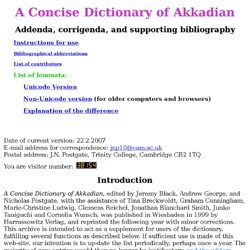
Postgate, Trinity College, Cambridge CB2 1TQ You are visitor number: Index of cuneiform pages" Akkadian Dictionary.